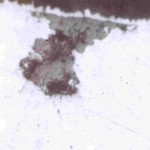Save 50% off bridge maintenance because you need less man power, less hours and less materials to permanently encapsulate lead paint and rust.

The Problem with Typical Protective Coatings Systems
In a slow economy we all need to find ways to do more with less. Most protective coatings systems do not meet real world maintenance requirements. In many situations, both corrosion and lead paint are present. Both situations are difficult to deal with on their own. Most protective coatings will not handle either well. That’s why most specifications require a near white or white abrasive blast to remove the problem and start with a clean slate. That’s ideal for the coating manufacturer, but very costly and hazardous.
Even with a clean slate, there can be problems with the typical three, and sometimes two coat protective coatings system.
Problems with multi-coat paint systems with zinc rich primer include:
- Intercoat Adhesion Difficulties
- De-adhesion from System Design Problems
- De-adhesion due to Saponification
- De-Adhesion from Contamination
- Cohesive Failure
- Vertical Cohesive Failure (Mudcracking)
- Lateral Cohesive Failure (Zinc Splitting)
- Effect of Cure Deficiencies
- Topcoat bubbling and
- Cohesive Weakening of zinc primer after recoating. – JPCL, September 1998, pp 34-48
Executed well, there is nothing wrong with a multi part coating system, but what if we didn’t need them? What if there was a way to get around these problems? Here is a look at a novel solution that address all three issues; top coating, corrosion and lead paint.
Corrosion Control with Rust Grip

Coating inventor and company founder of Superior Products International II Inc., J.E. Prichett, explains the product. “When other corrosion coatings are applied to surfaces after a completed white metal blast, corrosion redevelops after only six (6) months to two (2) years under the coating film, causing bubbles on the surface from off-gassing of the corrosion. This happens because the surface has developed flash rust before the corrosion coating was finally applied, and the coating was not designed to penetrate and encapsulate. As a result, corrosion reappears.
“Rust Grip® penetrates directly into and through 1/16-inch of surface rust, swells, anchors, locks, and encapsulates so that the surface cannot breathe, cannot get moisture, and cannot oxidize again. Where there is no air and moisture, there is no corrosion.
“Rust Grip® saturates deep into the pores of the metal or concrete substrate because it is made with low molecular weight solvents that act to provide wetting so that deep penetration can occur. After it penetrates, Rust Grip® draws moisture from the atmosphere which reacts with the active ingredients of the base component. This results in a gassing effect of the molecules causing them to expand and swell into all the pores to block out air, gasses, and moisture and to encapsulate the surface. After it encapsulates, Rust Grip® cures to a 6,780 psi surface tensile strength (concrete is about 3,500 psi by comparison) within three (3) weeks and continues to toughen over time”.
Rust Grip becomes a corrosion inhibitor because of it’s unique ability to seal out air and gasses moisture while encapsulating the surface.
Durability Facts:
- Surface tensile strength: 6,780+ psi
- Pull testing average: 1,480psi
- Passed 15,000 hours of salt spray test with a perfect score: 10 out of 10
- Certified water barrier: ASTM D6904 and ASTM D7088 hydrostatic & wind driven rain
- Exceptional adhesion: ASTM 5B rating
- Withstands temperatures up to 600F
- UV stable: no top coat needed
- ASTM D-4060; Abrasion Resistance (Taber test); 0.06g
- G85: Prohession over Rusted Metal
- Resistant to most solvents, chemicals and some acids
The End of Lead Paint Abatement
Rust Grip®‘s patented coating technology gives you the ability to permanently encapsulate lead paint without the added expense of abrasive blasting, elaborate containment systems and disposal of hazardous materials.
Encapsulation/Containment Facts:
- ASTM D 3359 Adhesion and Penetration – Penetrates 18 layers of exiting lead-based paint over surface
- ASTM E-1795 Encapsulation of Existing Lead-Based paints (meets all 21 requirements)
- Window Cycling Test for Encapsulation of Lead Based Paint:
a. Testing was done for encapsulating existing lead based paint on windows for HUD.
b. Window coated with RUST GRIP®
c. Coated surface showed no wear, friction burn, or lead-based paint exposure
d. Window was cycled a total of 29,700 times before test concluded.
Rust Grip® penetrates through, saturating the old paint, and anchors into the substrate. This locks the old coating into the substrate and makes it safe for demolition or top coating. Even very small particles are encapsulated with Rust Grip®. This is much different than paint bonding to the top surface.
The need for creating a cloud of lead paint dust through dry blasting mandated by the EPA is gone. All Rust Grip® normally requires for prep work is a thorough cleaning with a 3,000psi or greater power washer, degreaser and/or salt removal. Prep work is project dependent so consult the manufacturer for details. You must provide a clean solid and dry surface for any coating, including Rust Grip®. Paint chips are easily collect on 6 mill plastic ground cover and the lead is not water soluble. Safe and easy lead paint “abatement”.
You can replace the labor intensive, expensive and hazardous multi-coat protective coatings system with a Rust Grip® system that requires minimal prep work and a stand alone primer/top coat that lasts 15-20 years.
Traditional lead paint abatement is obsolete. Protective coatings systems will always be an important part in corrosion control. Rust Grip offers an environmentally friendly one component, one product coating that prolongs the life of steel and concrete structures at half the cost of normal approaches.
Case Study Summary: Simmons Army Airfield – Ft. Bragg, NC

Steel structures can be renovated instead of torn down and will have a long service life thanks to Rust Grip and Enamo Grip as a top coat.
“This advanced coating selection and implementation of a Rust Grip® system will provide the benefits of restoring structures to their optimum operating conditions, as well as reducing maintenance costs, and increasing safety.
“Rust Grip® offers the benefit of maximizing the economic life of existing LBP coatings while minimizing present expenditures and reducing worker exposure and hazardous waste generation.
“The technologies developed and demonstrated under this CERL project have dual use applications in the Department of Housing and Urban Development (HUD) for housing and Department of Transportation (DOT) for bridges”.
Protective Coatings for Corrosion Control and Lead Paint Abatement is a simple solution who’s time has come. We can no longer afford to waste time and money on outdated lead paint abatement methods mandated by the EPA. Rust Grip® has been field proven for 15 years on off shore oil rigs, pipe lines, brigdes and military posts, performing past expectations. Time to step into the 21st century world of Protective Coatings for Corrosion Control and Lead Paint Abatement with Rust Grip®! Contact your local authorized applicator, Tim Hoeffel, today for further information about moving your project forward.
Author: Tim Hoeffel
Better Painting & Coatings

